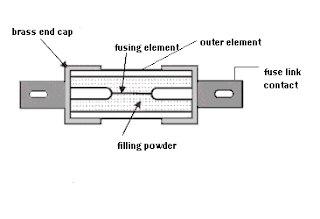AIR BREAK CIRCUIT BREAKER
Construction
In this type of Circuit Breaker arc extinction and contact
separation takes place in air at atmospheric pressure. Figure (a) shows closed
current carrying contacts. As the contacts are opened, arc is drawn between
them. The arc core is conducting part of plasma. Ionized air is contained in
surrounding medium. By cooling the arc, the diameter of arc core is reduced.
The arc is extinguished by lengthening the arc, cooling the arc and splitting
the arc. The arc resistance is increased to such an extent that the system
voltage can’t maintain the arc and arc gets extinguished.
The last figure illustrates normal arrangement of an air break
circuit breaker. This type of breaker is used for medium and low voltages.
There are two sets of contact: Main contact (1) and Arcing contact
(2). Main contacts conduct the current in closed position of the breaker. They
have low contact resistance and are silver plated. The arcing contacts (2) are
hard, heat resistance and are usually of copper alloy. While opening the
contact, the main contacts dislodge first. The current is shifted to arcing
contacts. The arcing contacts dislodge later and arc is drawn between them (3).
This arc is forced upwards b the electromagnetic forces and the thermal action.
The arc ends travel along the Arcing horns. The arc moves upwards and is split
by splitting plated (5). The arc is extinguished by lengthening, cooling,
splitting, etc. But this Air break Principle is used for DC Circuit Breaker upto 15KV.
Arc Extinction in A.C. Air Break Circuit Breaker
In A.C. Air Break Circuit Breaker, the arc is lengthened, cooled
and splitted so as to increase the resistance of the arc. The rapid increase in
the arc resistance causes the reduction in the fault current and the fault
current does not reach the prospective high value. The arc extinction process
is assisted by current zeros and A.C. wave. The voltage drop across the
arc goes on increasing with the increase in arc resistance and at a current
zero, when the recovery voltage across the contacts is less than the arc
voltage, the arc gets extinguished.
Arcing Horns
As soon as the arc leaves the vicinity to the contacts it
communicates to the pair of run out horns. In doing so outer blow out system is
switched on. There blow out coils provide a magnetic field such that the arc
footing is subjected to strong magnetic field. We know from the electromagnetic
theory that force is experienced by current carrying element of length dl meters, carrying current I amperes and placed in magnetic field B Wb/m2 is
given by,
dF=I(dl*B)
By virtue of this force the arc travels upwards and its length
increases. The tips of the arc run along the arc runners and come to its
extreme point. As the length of arc increases at a particular length the system
voltage is unable to maintain the arc and the arc is extinguished. For systems
having low inductance the energy (½ LI2 ) is small and arc gets
extinguished before reaching the extremity of runners. For high inductance
circuits special techniques such as air blast, additional larger acing horns
etc are used.
*other types of CB will be posted soon



